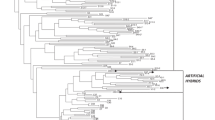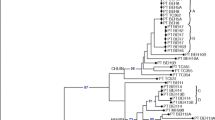Abstract
A study of genetic diversity was conducted among four wild Arracacia species (A. elata, A. equatorialis, A. incisa and A. xanthorrhiza), using three accessions per species, 20 plants per accession referred to as a population, 100 morphological characters and five AFLP primer combinations producing 202 AFLP markers. Genetic diversity was well described using these morphological descriptors and AFLP markers. Analysis of molecular variance showed a total variation of 49.5% which was attributed to differences between species; variation between populations within species amounted for 25.8%, while variation within populations accounted for 24.6%. On the basis of morphological and molecular characteristics, accessions considered previously as A. equatorialis could be regrouped with A. xanthorrhiza. These comparisons and multivariate analysis resulted in the selection of 28 morphological characters considered as discriminant to identify the Arracacia species from Peru. According to our morphological and molecular analysis, three wild species of Arracacia genus were clearly identified: A. elata, A. incisa and A. xanthorrhiza. However, A. equatorialis which was not well identified botanically could be considered as very close to A. xanthorrhiza.





Similar content being viewed by others
References
Blas R, Arbizu C, Rodriguez G (1997) Número de cromosomas de la arracacha (Arracacia xanthorrhiza Bancroft). Anales Cientificos 32:44–54
Blas R (1998) Caracterización y evaluación de arracachas cultivadas (Arracacia xanthorrhiza Bancroft) del Perú. Tesis M. Sc., Universidad Nacional Agraria La Molina. Lima, Perú, 100 pp
Blas R (2000) Diversité génétique et éléments de physiologie chez l’arracacha (Arracacia xanthorrhiza Bancroft). Mémoire de fin d’études du Diplôme d’Etudes Approfondies, Faculté Universitaire des Sciences Agronomiques de Gembloux, Belgique, 67 pp
Blas R (2005) Diversity of Arracacia species in Peru. Ph.D. thesis. Gembloux Agricultural University, Belgium. 154 pp
Blas R, Hermann M and Baudoin J-P (2007) Analysis of the geographic distribution and relationships among Peruvian Arracacia wild specie. Genet Resour Crop Evol (in press)
Brako L, Zarucchi J (1993) Catálogo de las angiospermas y gimnospermas del Perú. Vol. 45, Missouri Botanical Garden, St. Louis, Missouri, USA, 1286 pp
Bukasov SM (1930) Las plantas cultivadas de Mexico, Guatemala y Colombia. Leningrado, Rusia. Traducido de la versión inglesa de M.H. Byleved por Jorge León (1985). CATIE Unidad de Recursos Genéticos, Turrialba, Costa Rica, 168 pp
Centro Internacional de la Papa (CIP) (1998) Molecular biology laboratory protocols: plant genotyping. Herrera MR, Zhang D, Ghislain M (eds) Genetic Resources Department, training manual, CIP, 2nd edn, Lima, Peru, 40 pp
Cobo PB (1956) Biblioteca de autores españoles, desde la formación del lenguaje hasta nuestros dias. Tomo I, Libro IV Estades, Artes Graficas. Madrid, España, pp 154–199
Constance L (1949) The South American species of Arracacia (Umbelliferae) and some related genera. Bull Tor Bot Club 76(1):39–52
Constance L (1997) An instance of East–West confusion in Chinese Umbelliferae, or Arracacia out of Asia. Edinb J Bot 54(1):99–104
Constance L, Affolter JM 1995a. Arracacia ravenii (Apiaceae), a new species from southern Mexico. Novon 5:22–23
Constance L, Affolter JM 1995b. Three new species and a new combination in Arracacia Bancroft (Umbelliferae/Apiaceae). Brittonia 47(3):320–327
Crisci J, López M (1983) Introducción a la teoría y práctica de la taxonomía numérica. Serie de biología No.26, Secretaria General de la Organización de los Estados Americanos (OEA). Programa Regional de Desarrollo Científico y Tecnológico, Washington D.C., 132 pp
Dagnelie P (1986) Analyse statistique à plusieurs variables. 3eme réimpression, Les Presses Agronomiques de Gembloux, Gembloux, Belgique, 362 pp
De Candolle A (1835) Introduction à l’étude de la Botanique, traité élémentaire de cette science. Tome I, Librairie Encyclopédique de Roret, Paris, France, 534 pp
Doyle JJ, Doyle JL (1990) Isolation of plant DNA from fresh tissue. Focus 12:13–15
Excoffier L, Smouse P, Quattro J (1992) Analysis of molecular variance inferred for metric distances among DNA haplotypes: application to human mitochondrial DNA restriction data. Genetics 131:479–491
Ghislain M, Zhang D, Fajardo D, Huamán Z, Hijmans R (1997) Genetic diversity analysis in a cultivated Andean potato, S. phureja Juz. et Buk. The International Potato Center (CIP), Program Report 1995–1996. Lima, Peru, pp 77–83
Hancock JF (2004) Plant evolution and the origin of crop species, 2nd edn. CABI Publishing, Wallingford, UK, 313 pp
Hermann M (1997) Arracacha (Arracacia xanthorrhiza Bancroft). In: Andean roots, tubers: Ahipa, arracacha, maca and yacon. Promoting the conservation and use of underutilized and neglected crops. In: Hermann M and Heller J (eds) Institute of Plant Genetics and Crop Plant Research, Gatersleben/International Plant Genetic Resources Institute, Rome, Italy, pp 75–172
Hiroe M (1979) Umbelliferae of the World. Ariake Book Company, Tokyo, Japan, 2129 pp
Jaccard P (1908) Nouvelles recherches sur la distribution florale. Bull Soc Vaudoise Sci Nat 44:223–270
Knudsen SR (2003) Reproduction biology of the Andean root crop arracacha (Arracacia xanthorrhiza Bancroft var. xanthorrhiza) and the taxonomic status of the South American Arracacia Bancroft species with special emphasis on the position of the cultivated arracacha and related wild species. Ph.D. thesis. Botanical Section, Department of Ecology, The Royal Veterinary and Agricultural University. Copenhagen, Denmark, 150 pp
Mathias ME and Constance L (1944) Arracacia. North American Flora. The New York Botanical Garden. 28B (Part 1): 90–102
Mathias ME and Constance L (1962) Arracacia Bancroft. In: Mathias ME and Constance L (eds) Flora of Perú. Field Mus Nat Hist Bot 13(1) Part V-A: 13–19
Mathias ME, Constance L (1968) Two new apioid Umbelliferae from southern Mexico. Collectanea Botanica 7(Fasc. II, no. 43):759–766
Mathias ME, Constance L (1973) New and reconsidered Mexican Umbelliferae. Contr Univ Michigan Herbar 11(1):1–24
Palm R (2000) L’analyse de la variance multivariée et l’analyse canonique discriminante: principes et applications. Notes de statistique et d’informatique 2000/1, Faculté Universitaire des Sciences Agronomiques, Gembloux, Belgique, 40 pp
Pimenov MG, Leonov MV (1993) The genera of the Umbelliferae . Royal Botanic Gardens, Kew, UK, 156 pp
Rohlf F (2000) NTSYS PC: Numerical taxonomy and multivariate analysis for the IBM PC microcomputers (and compatibles), version 2.1 user guide. Applied Biostatistics Inc. Stony Brook, New York, USA, 39 pp
Royal Horticultural Society (RHS). (1995) Colour Chart. London, UK
Vos P, Hogers R, Bleeker M, Reijans M, Van de Lee T, Hornes M, Frijters A, Pot J, Peleman J, Kuiper M, Zabeau M (1995) AFLP: a new technique for DNA fingerprinting. Nucleic Acids Res 23(21):4407–4414
Yacovleff E, Herrera F (1934) Racacha. En: El mundo vegetal de los antiguos peruanos. Botánica Etnológica. Revista del museo nacional, Lima, Perú 3(3):309–310
Acknowledgements
This research was supported by grants from Coopération Universitaire au Développement (CUD) and Direction Générale de la Cooperation Internationale, Belgium.
Author information
Authors and Affiliations
Corresponding author
Rights and permissions
About this article
Cite this article
Blas, R., Ghislain, M., del Rosario Herrera, M. et al. Genetic diversity analysis of wild Arracacia species according to morphological and molecular markers. Genet Resour Crop Evol 55, 625–642 (2008). https://doi.org/10.1007/s10722-007-9269-7
Received:
Accepted:
Published:
Issue Date:
DOI: https://doi.org/10.1007/s10722-007-9269-7




